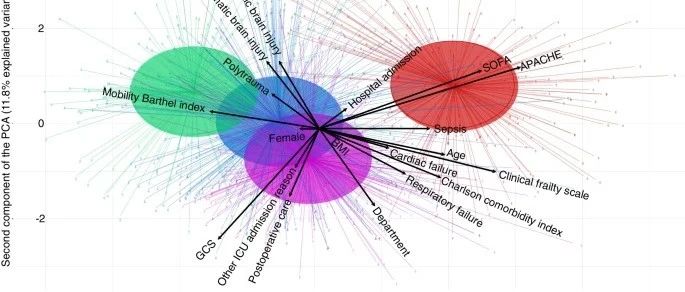文献学习——使用个体化学习方法对危重患者举行聚类,可以优化 icu 中活动量

Background: While early mobilization is commonly implemented in intensive care unit treatment guidelines to improve functional outcome, the characterization of the optimal individual dosage (frequency, level or duration) remains unclear. The aim of this study was to demonstrate that artificial intelligence-based clustering of a large ICU cohort can provide individualized mobilization recommendations that have a positive impact on the likelihood of being discharged home.
Methods: This study is an analysis of a prospective observational database of two interdisciplinary intensive care units in Munich, Germany. Dosage of mobilization is determined by sessions per day, mean duration, early mobilization as well as average and maximum level achieved. A k-means cluster analysis was conducted including collected parameters at ICU admission to generate clinically definable clusters.
Results: Between April 2017 and May 2019, 948 patients were included. Four different clusters were identified, comprising “Young Trauma,” “Severely ill & Frail,” “Old non-frail” and “Middle-aged” patients. Early mobilization (< 72 h) was the most important factor to be discharged home in “Young Trauma” patients (ORadj 10.0 [2.8 to 44.0], p < 0.001). In the cluster of “Middle-aged” patients, the likelihood to be discharged home increased with each mobilization level, to a maximum 24-fold increased likelihood for ambulating (ORadj 24.0 [7.4 to 86.1], p < 0.001). The likelihood increased significantly when standing or ambulating was achieved in the older, non-frail cluster (ORadj 4.7 [1.2 to 23.2], p = 0.035 and ORadj 8.1 [1.8 to 45.8], p = 0.010).
Conclusions: An artificial intelligence-based learning approach was able to divide a heterogeneous critical care cohort into four clusters, which differed significantly in their clinical characteristics and in their mobilization parameters. Depending on the cluster, different mobilization strategies supported the likelihood of being discharged home enabling an individualized and resource-optimized mobilization approach.
figure 1. strobe diagram
figure 2. biplot of the cluster centers on the first two dimensions of a principal components analysis (pca).

figure 3. synthetic figure summarizing the main findings.
本文链接: https://www.yizhekk.com/0101256508.html








